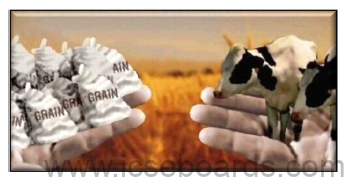Students should read the Meaning and Functions of Money ICSE Economics Class 10 notes provided below. These revision notes have been prepared based on the latest ICSE Economics Books for Class 10 issued for the current academic year. Our teachers have designed thee notes for the students are able to understand all topics given in Economics in standard 10 and get good marks in exams
ICSE Class 10 Economics Meaning and Functions of Money Revision Notes
Students can refer to the quick revision notes prepared for Chapter Economics Meaning and Functions of Money in Class 10 ICSE. These notes will be really helpful for the students giving the Economics exam in ICSE Class 10. Our teachers have prepared these concept notes based on the latest ICSE syllabus and ICSE books issued for the current academic year. Please refer to Chapter wise notes for ICSE Class 10 Economics provided on our website.
Meaning of Money
Money is a thing which is commonly accepted as a medium of exchange. Money is an instrument which serves as a medium of exchange, a measure of value, a store of value and a standard for deferred payments.
Difficulties of the Barter System
The barter system is a system where goods were exchanged for goods in the olden days. The sale and purchase of goods occur at the same time, and their value also remains equal at that point. After money came into existence, a person could purchase or sell goods with cash without selling or purchasing any goods at that point. Thus, the act of purchase and sale was separated.

- Lack of double coincidence of wants: A person with a particular good has to find a person who has the good of his wants and he should also possess the wanted good of the other person. Hence, the exchange of good is not possible without the double coincidence of wants.
- Lack of store of value: Wealth is stored in terms of goods as there was no money in existence, storage of goods cost, loss of value and movement of transfer. Hence, it is not practically possible to store the people’s purchasing power.
- Lack of divisibility: All types of goods cannot be divided and sub-divided. In the absence of a common medium of exchange, a problem arises when a big indivisible commodity is to be exchanged for a smaller commodity.
- Lack of deferred payment: Money has made deferred payments easier. When money is borrowed, the principal and interest amounts have to be returned to the lender. However, these transactions are not possible in goods and services.
- Problem of storing wealth: In the absence of money, individuals have to store wealth. The value of stored commodities may change in the due course of time. Storing a particular good for longer period is more expensive.
Evolution of Money
The evolution of money has passed through various stages with time, place and circumstances.
- Commodity money: Various commodities used as money is known as commodity money. It is the most primitive form of money. However, certain problems such as improper standardisation, indivisibility and storage difficulty made this form of money an unsuitable medium of exchange.
- Metallic money: Mono-metalism and bi-metalism, i.e. valuable metals such as gold and silver, were used as a medium of exchange. As society progressed, different sections of people agreed to consider some precious metals as a common medium of exchange. The gold coin was introduced in India by King Kanishka of the Kushan Dynasty during the first century AD.
- Paper money: The paper currency system is a system where coins and currency notes are used as a medium of exchange. Because of the expansion of trade and commerce and an increased demand for money as a common medium of exchange, metallic money was replaced by paper money. The Central Bank of a country assumes supreme authority in issuing paper money of definite denominations and values. A medium of exchange which is generally acceptable and enforced by law is called fiat money. For example, rupee notes and coins are legal tender.
- Bank money: At the final stage of evolution of money, demand deposits with commercial banks are considered bank money. Demand deposits are current account deposits with banks or other financial institutions which are payable on demand by cheques. Thus, cheques drawn on the demand deposits of commercial banks can be used as a medium of exchange.
Narrow and Broad Definitions of Money
Currency, demand and time deposits in commercial banks and other types of deposits are the total amount of money in an economy. Definition of supply of money varies depending on the components which are included and excluded.
- Narrow definition of money
M1 = Currency with the public + demand deposits with the commercial banks + deposits kept by commercial banks with the Reserve Bank
M1 = C + DD + OD - Broad definition of money
M2 = M1 + Savings deposits with post office savings banks
M3 = M2 + Term deposits in commercial banks
M4 = M3 + Savings with the post office other than in the form of National Saving Certificates
- Demand deposits are current account deposits with banks or other financial institutions which are payable on demand by cheques. Banks do not provide interest payments on deposits.
- Time deposits are fixed term deposits with a fixed maturity period and their term of deposit varying from 7 days to 10 years. These deposits cannot avail the benefits of issuing cheques against them and cannot be payable on demand, but time deposits can avail interest towards the deposited amount.
Features of Money
- General acceptability: It should be accepted by people freely in exchange for goods and services.
- Divisibility: It should be easily divisible into smaller parts to facilitate the transaction more easily.
- Durability: Currency notes and coins are used repeatedly and continue for many years.
- Cognisability: It must be easily recognised and have certain distinct marks to avoid confusion by the receiving person.
- Portability: It can be transferred easily from one place to another at a lot.
- Homogeneity: Various units of money must be homogeneous in quality.
- Stability: It should be stable in value to serve as a measure of value.
Kinds of Money
- Standard money or currency money consisting of currency notes and coins are called fiat money. It serves as money on the order of the government.
- Bank money refers to bank deposits which can be withdrawn by bank cheques and bank drafts.
- Near money refers to the highly liquid assets which can easily be converted to cash at short notice such as bank deposits and treasury bills.
Functions of Money

- Primary Functions
o Money acts as a medium of exchange. The major function of money is to facilitate the process of exchange by removing the defects of the barter system.
o Money is the measure of value. It is the monetary expression of the market value of goods and services. - Secondary Functions
o Standard of deferred payments: Deferred payments refer to those payments which are made in the future. Money has made deferred payments easier. When money is borrowed, the principal and interest amounts have to be returned to the lender. However, these transactions are not possible in goods and services. Money performs this function more effectively.
o Store of value: People keep their wealth in the form of money because money is the most liquid form of wealth. Savings in the form of money is maintained for purchasing commodities with the savings in the future. In this case, the values of commodities are being stored. Hence, money acts as a store of value.
o Transfer of value: Money is also a means of transferring a given value from one person to another. If any person purchases a commodity, then the value of that commodity can easily be transferred from the buyer to the seller through a payment in terms of money. - Contingent Functions
o Assisting production decisions: The producers have to decide the amount of factors of production to make their profit. They have to make factor payments to those factors of production in terms of money. Thus, the money prices of those factors help the producer to make necessary decisions.
o Assisting consumption decisions: The consumption of the consumer depends on the income level and money-prices of the commodities in the market. Thus, the income of the consumer and money-prices of the commodities influence the consumption decision of individuals.
o Assisting distribution of national income: The owners of various factors of production sell their factors at market prices. They receive money wages, interest, rent and profits as factor incomes. All these incomes constitute the national income of a country. Hence, the distributions of national income among the owners of different factors are determined by the money prices of those factors.
o Assisting the operation of a credit system: Money forms the basis of credit operations performed by the business and financial institutions in a country.
Importance of Money
When there is development of an economy, there is an abnormal increase in economic transactions. As money is generally acceptable, it is essential as a medium of exchange. Money is considered a dynamic factor because of the following reasons:
- Money facilitates exchange beyond limits.
- It facilitates accumulation of wealth for the purpose of investment.
- It facilitates the flow of capital from one place to another within and outside countries.
- It helps in economic stability and promotes the growth of the nation.



